
A document of description words that can be used to help build 4 point rubrics.
- Subject:
- 21st Century Competencies
- Elementary Education
- Material Type:
- Homework/Assignment
- Author:
- Arlene Low
- Date Added:
- 10/05/2021

A document of description words that can be used to help build 4 point rubrics.
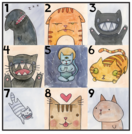
These check ins are a quick way to get your finger on the pulse of your classroom and respond accordingly!

This mobile training program provides specialized critical care skill training to STARS crews and other emergency care providers. The first mobile program of its kind in North America, it features a human patient simulator which replicates complex medical and traumatic problems over and over again. It offers medical personnel the opportunity to test and practice their reactions and skills, leading to a high degree of familiarity and confidence.
The mannequin: speaks and breathes, blinks and has reactive pupils, has a heartbeat and a pulse
accurately mirrors human responses to such procedures as CPR, intravenous medication, intubation, ventilation and catheterization.
The mannequins have been installed in four motorhomes, creating large mobile emergency rooms. Additionally, STARS has a wireless mannequin that can be transported in a specially-modified SUV. This mannequin can be used in a variety of environments including hospital emergency rooms, classrooms, and mock accidents scenes.

STEAM education results in students who take thoughtful risks, engage in experiential learning, persist in problem-solving, embrace collaboration, and work through the creative process. These are the innovators, educators, leaders, and learners of the 21st century!

SaskOutdoors (Saskatchewan Outdoor and Environmental Education Association) encourages educators and people who participate in outdoor recreation to practice and teach environmental responsibility.

Among numerous teaching techniques, we recommend paying attention to scaffolding. As in construction sites, scaffolding in education means providing support for students while they are doing their work – studying. This article will cover the key benefits of scaffolding and provide ideas on how to incorporate it into the classroom.

The Build Your Skills Learning Hub is your personal hub and all you need to succeed in a career in the construction trades.
Free sign up
Tons of resources
All construction trades
Connection to available union jobs
Info on union apprenticeship training
*video tutorials, instructions, practice activities, quizzes

Peg Dawson and Richard Guare are two of the leading experts on executive skills and how to teach them. This is their website, offering resources and information about professional development opportunities.

Smash Boom Best is a debate show for kids and families from the makers of the award-winning podcast, Brains On! Every episode takes two cool things, smashes them together and lets you decide which is best. Our debaters use facts and passion to make their case -- teaching listeners how to defend their own opinions along the way.

Global and Canadian Defenders for human rights have changed societal conditions and provide inspiration for students. The overall goal of Speak Truth to Power Canada is to raise student awareness that advances in human rights come through the actions of individuals.
In this lesson plan on Truth and Reconciliation you will find:
- An interview with Chief Littlechild including his biography.
- Student activities that support the theme of this lesson, including reflection activities on Chief Littlechild’s life experiences, Residential Schools in Canada, the Truth and Reconciliation’s findings and recommendations on how to move forward.
- Three brief community defender profiles to expand the lesson and encourage students to identify with a variety of defenders for human rights.
To support the lesson on Truth and Reconciliation, you will also find:
1. Sections or articles of selected legal instruments that are tied to the theme of Truth and Reconciliation.
2. A student activity that links the Moments in Time timeline of advancements and setbacks in human rights from a Canadian perspective.
You can, of course, choose to use any or all of the suggested student activities.
Warning: All student activities are applicable to Grade 5 to 12 students, with viewer discretion warning. Teachers should review the suggested resources prior to undertaking with their students.
*This set of lessons is also available in Cree.
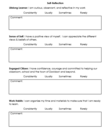
This is a self reflection document to be used at any point during the year with your students - but used specfically during report card time or three-way conferences. It provides students in kid-friendly language a way of understanding the FASA conditions and how they are able to apply these to their own habits at school. It is a great tool to use and assess during parent, student, teacher conferences. Co-created by Kira Toews and Brenna Siroski

Ideas for schools, municipalities, organizations and individual citizens for celebrating Earth Day.

After completing a pre-assessment survey of their knowledge of electricity, students compare how much energy different types of light bulbs use and relate these to their monthly power bill. They then evaluate the short term economic and carbon footprint aspects of the energy alternatives available.

A great video on Explicitly teaching. A must watch!
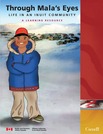
This series of lesson plans, built around the first-person narrative of a 12-year-old Inuk boy, will help you and your students appreciate life in the Inuit community of Salluit, in the northern part of Nunavik, Northern Quebec. Although designed for students from 9 to 12 years of age, some of the lesson plans and strategies in this unit can be adapted for other grade levels. Suggested activities and lists of research resources offer exciting and engaging opportunities to learn more about the history, customs and traditions of Inuit in Canada.
The aim of this booklet is to enhance the knowledge of students about the history, cultures and traditions of Inuit and, in particular, those who live in Canada's northern Inuit community of Salluit.
By completing the lessons in this booklet, students will be able to:
- express an appreciation for the strong traditions and unique culture of the Inuit people, in various ways
- describe the various developments that affected Canada's Arctic from its early history to the present
- locate the community of Salluit and its neighbouring Inuit municipalities on a map of Canada
- relate the similarities and differences between life in Salluit and life in their own community.
Through Mala's Eyes...Life in an Inuit Community offers educators opportunities to address provincial learning outcomes in the social studies, history and geography portions of their curriculum. Given the nature of the suggested activities, students will also address learning outcomes in language, the arts and mathematics.
*Audio recordings of student readings are available through the website, but are not hyperlinked in the pdf document.
*With some slight adaptations, this unit can be completed without technology.

"Say goodbye to the time crunch! This video provides practical time management tips and strategies to help teens bring better balance to their lives. It is possible to achieve academic and extracurricular goals while staying well rounded—let this video guide the way." (Common Sense Media)

Tomatosphere™ offers an excellent opportunity to have your students think and act like scientists as they practice their inquiry skills and develop understandings of the nature of science and the concept of a fair test.
In the spring, participating classrooms receive two packages of tomato seeds. One package contains seeds sent into space or treated in space-simulated conditions. The other contains untreated "control" seeds. Students plant the seeds and conduct experiments to explore the effects of the space environment on the germination of tomatoes. Through Tomatosphere™, students learn how to conduct a scientific experiment and compare the number of seeds that germinate for the two groups of seeds.
While completing the Tomatosphere™ program, students investigate how to supply space exploration missions with life-support requirements—food, water, oxygen and a way to consume the carbon dioxide exhaled by astronauts—while also discussing the many issues and research involved in space exploration.
Teachers can expand on the basic Tomatosphere™ Seed Investigation by connecting it to studies of plants, space, nutrition, math or the environment, depending on grade and curriculum.
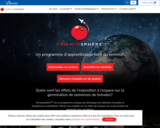
"Tomatosphere™ offre une excellente opportunité pour permettre à vos élèves de penser et agir comme des scientifiques tout en pratiquant leurs compétences en recherche et en développant leur compréhension de la nature de la science et du concept d'une expérience équitable.
Au printemps, les salles de classe participantes reçoivent deux paquets de graines de tomates. Un paquet contient des graines envoyées dans l'espace ou traitées dans des conditions simulées d'espace. L'autre contient des graines "témoins" non traitées. Les élèves plantent les graines et réalisent des expériences pour explorer les effets de l'environnement spatial sur la germination des tomates. Grâce à Tomatosphere™, les élèves apprennent comment mener une expérience scientifique et comparent le nombre de graines qui germent pour les deux groupes de graines.
Pendant le programme Tomatosphere™, les élèves étudient comment fournir aux missions d'exploration spatiale les besoins en support de vie tels que la nourriture, l'eau, l'oxygène et un moyen de consommer le dioxyde de carbone expiré par les astronautes, tout en discutant des nombreux problèmes et recherches liés à l'exploration spatiale.
Les enseignants peuvent étendre l'Investigation de base sur les graines Tomatosphere™ en la reliant à des études sur les plantes, l'espace, la nutrition, les mathématiques ou l'environnement, en fonction du niveau et du programme d'études."
Tous droits réservés
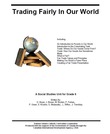
An excellent resource from the Eastern Ontario Catholic Curriculum Cooperative. This resource includes an in-depth simulation to place students into the “shoes” of those living in poverty. “This unit will help engage students to actively explore international trade, development and co-operation issues as they pertain to Canada, its trading partners, and the fair trade system.”

This resource effectively illustrates the ways in which animals are important to the health and future of the planet. Four lessons demonstrate how human activities, including those related to climate change can result in habitat fragmentation and threaten the viability of entire ecosystems. The resource includes a teacher's guide, background information, student activity pages, videos and extension ideas for individual, group and community action.
Activity One: What’s your View? (1 x 60 minutes)
Teachers set up a 'four corners' activity in which students read a variety of statements concerning animal welfare and decide if they agree or disagree. The class then discusses as a group the importance of animals in sustaining healthy ecosystems and the value of their relationships with humans.
Activity Two: Video (1 x 60 minutes)
Students watch a video called “Why Animals Matter” and complete a short quiz to check their understanding of key concepts raised in the video. A discussion follows on what can be done to make the world a better place for animals. Suggestions for extension activities are included.
Activity Three: Eco-investigation (3 x 60 minutes)
Students go outside to study local biodiversity. Working in groups, they select a 2m square sample site near the school yard and determine the variety of plant, fungi and animal life found. The inventory includes the abiotic characteristics of soil, rocks, water sources as well as any evidence of human disturbance. Students are also asked to take notice of the resources that species need to survive (food, water, cover and space) and how humans have impacted these resources.
Activity Four: Understanding Habitat (3 X 60 minutes)
After a discussion on the inter-dependency of the four core elements of a habitat, the class is invited to brainstorm ideas as to the causes and effects of habitat fragmentation and the importance of wildlife corridors. Students then review a newspaper article describing how habitat fragmentation due to road construction in parts of India has impacted elephant populations. Four groups of students take on the role of stakeholders in a wildlife corridor project for the benefit of these elephants. Groups must develop a persuasive statement to reflect their point of view. Peer evaluation and class discussion follow.
An extension activity suggests students research the habitat requirements of a wild animal, how these needs can be threatened by human disturbance and what solutions should be considered.